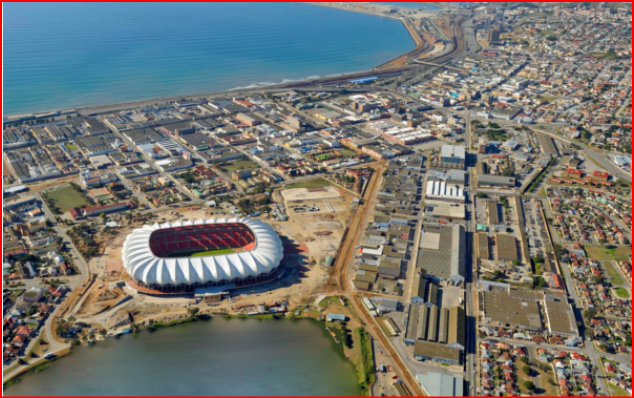
Port Elizabeth is the largest City in the Eastern Cape Province, it is known as 'The Windy City' or the 'Friendly City'. One of the countries largest seaports, the city was originally founded as a settlement for British emigrants. The Area was previously inhabited by the San and the Xhosa. The City now forms part of the Nelson Mandela Metropolitan Municipality, which includes Uitenhage and Despatch.
"Many South Africans are learning how to pronounce "Gqeberha", the new name for the city of Port Elizabeth."
It is the Xhosa name for the 'Baakens River' which flows through the City. Xhosa is one of South Africa's 11 official languages and one of the few in the world that has a "click" sound, which can be difficult for non-Xhosa speakers to master.
The Donkin Heritage Trail in the Nelson Mandela Bay Metro City of Port Elizabeth is mainly based around the Central District and consists of a large collection of Historic Victorian Buildings and Monuments. These tell the story of the first British Colonial Settlers to arrive on the shores of Algoa Bay.
"The Donkin Heritage Trail in Port Elizabeth has a great love story in this Cities past: "Port Elizabeth, or “PE” as South Africans prefer to call it, was named after the beloved wife of Rufane Donkin, who was once the acting Governor of the Cape Colony. Elizabeth and Rufane were true star-crossed lovers in a time of arranged marriages, and shortly after they were wed, she accompanied her husband when he was called to India for service.
She died soon after giving birth to their son, George David. A grief-stricken Rufane left for England, with his baby son and his wife’s embalmed heart. On his stopover in Cape Town, he was informed of his new position in South Africa and sent to Algoa Bay to supervise the new 1820 Settlers arrivals. He named the site of the settlers’ landings after Elizabeth and built a pyramid of remembrance to her on the Hill that is now called the; 'Donkin Reserve'. Just 20 years later, back in England, Rufane took his own life – on the anniversary of Elizabeth’s death"- This sad love story is the centre pivot of the Donkin Heritage Trail, which actually begins below the Hill in Govan Mbeki Avenue. There’s a collection of truly marvellous mid-1800 Buildings that include: 'Grey's School Institute, the Main Library, City Hall and the more recent, 'Feather Market Centre.'
The Donkin Reserve itself has an auspicious new resident in the form of a metal cut-out statue of a jubilant Nelson Mandela, part of the Voting Line Sculpture. Around the Reserve itself are: 'Fort Frederick (the City’s first structure); Prince Alfred’s Guard Drill Hall; a number of Cathedrals and Churches; the London-like Havelock Square; and a series of Settler Cottages and classic old Hotels.'
https://www.bbc.com/news/world-africa-56182349 accessed on 24 February 2021
Anon. (unknown) ‘Frontier Country: History’ [online] Available at: www.grahamstown.co.za [Accessed 3 September 2010] |Anon. (unknown) Frontier Wars website [online] Available at: www.frontierwars.co.za [Accessed 3 September 2010]|Anon. (unknown) ‘The Xhosa Wars’ [online] The Control and Administration of Port Elizabeth's African Population, 1834 - 1923. CONTREE. 26. 12-21.|Baker, J. (1990)Small Town Africa- Studies in Rural-Urban Interaction. Sweden: Nordiska Afrikainstitutet.|Backhouse, J. (1844) A Narrative of a Visit to the Mauritius and South Africa. London: Hamilton, Adams.|Caldwell, S.E. (1987) The Course and Results of the Plague Outbreaks in King William's Town, 1900-1907. Unpublished BA Hons Treatise, Rhodes University, Grahamstown.|Christopher, A.J. (1991) Port Elizabeth Guide. University of Port Elizabeth.|Clayton, A.J. (1986) Facts and Figures. Port Elizabeth: City Engineer's Department.|Delmonte, L. (1991) One City Concept: Land Use. Port Elizabeth: Metroplan.|Frescura, F. and RADFORD,D. (1982)The Physical Growth of Johannesburg. Johannesburg: University of the Witwatersrand.|Giliomee, H. et al. (2007) New History of South Africa. Tafelberg Publishers: Cape Town, pp. 77-8.|Howcroft, P. (unpublished encyclopedia, part of SAHO archive)|Infraplan (1988) Port Elizabeth Metropolitan Study. East London: INFRAPLAN.|Lemon, A. (1991) Homes Apart. Cape Town: David Philip.|Oberholster, JJ. (1972) The Historical Monuments of South Africa. Cape Town: NMC. |Rosenthal, E. (1970) Encyclopaedia of Southern Africa. London: Frederick Warne.|Strategic Facilitation Group (1991) Development Facilitation. Port Elizabeth: SFG.|Taylor, Beverley (1991) Controlling the Burgeoning Masses: Removals and Residential Development in Port Elizabeth's Black Areas 1800 - 1900. Working Paper No 51. Grahamstown: Institute for Social and Economic Research.